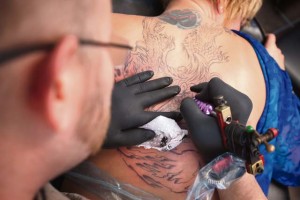by Staff Sgt. Alexander A. Burnett
21st Theater Sustainment Command Public Affairs

Service members need to consider their career and their future before getting a tattoo. Tatoos are not only expensive but can be very painful. It is reported that 17 percent of Americans regret getting a tattoo and 11 percent have or will get a tatoo removed.
The tattoo policy has been the subject of significant attention in the last several months, but tattoos are still authorized for service members provided they are not on the neck or face and are not degrading, racially charged or offensive, according to Army Regulation 670-1, Wear and Appearance of Army Uniforms and Insignia.
Similarly, Air Force Instruction 36-2903 prohibits any tattoos/brands anywhere on the body that are obscene, commonly associated with gangs, extremist, and/or supremacist organizations or that advocate sexual, racial, ethnic or religious discrimination. For Air Force members, excessive tattoos/brands or tattoos on the neck, head, face, tongue or lips are also prohibited. Excessive is defined as markings that exceed 25 percent of the exposed body part and are readily visible in any uniform combination.
Service members should consider their career, choose their artist well and be prepared for pain before making the decision to have that colorful, permanent body modification inked into the skin, commonly called a tattoo.
Service members desiring to get their first tattoo or just their first tattoo in Germany should conduct the proper research before making a permanent commitment to their bodies.
“Tattooing is considered a surgical procedure and is not without risk. Tattoos, even with proper care, can become infected, cause a severe skin allergy and turn into an eye-sore rather than a work of art,” said Lt. Col. Chad Hendrickson, chief of dermatology at Landstuhl Regional Medical Center.
Hendrickson advises service members think of their career before getting a tattoo.
“Those who don’t know their service-specific regulations risk counseling and separation from military service if they do not have the tattoo removed,” he said. “Laser treatment sessions can be very painful, especially on larger tattoos. Often, the laser treatment is more painful than the tattoo, and it may take 20 or more treatments to fade significantly.”
Before starting the process of finding a tattoo shop, selecting an artist and paying for the tattoo, have an idea of what design will be tattooed.
Tattoo shops and artists will be better able to design and execute a tattoo installation if they have a general idea of what their client wants. Also, remember this is a permanent addition to a service member’s body and should be tasteful.
“Knowing what you want is just as important as selecting your artist,” said tattoo artist Tim Baxley. “Walking in without an idea or with the intent of picking a design off the wall will get you either a generic tattoo or a frustrated artist.”
The first step is identifying the shop and artist that will install the tattoo. When researching a tattoo shop or studio, check the Internet or local publications for ratings. When physically visiting for the shop, look at how clean they are and ask questions about their sterilization process.
“Tattoo shops should always be clean and use disposable needles…it is the only way to ensure they are sterile and safe,” Baxley said. “For their tubes, which house the needle on the machine, they can either be disposable or should be sterilized with an autoclave.”
If the facilities seem safe and the reviews are acceptable, it is time to select an artist. Before accepting the first tattoo artist who steps forward, ask to see their portfolios and decide which artist is best. Every artist has their own style and technique and some are better suited than others.
“You are about to get a piece of art permanently put into your skin. This is an important decision,” Baxley said. “You need to find a tattoo artist who has the style you want. This is a serious decision; take the time to get an artist who will take it as seriously as you do.”
The place is found, the artist selected and it is time to get the tattoo installed. Once again, this is surgery without anesthetic, and it will hurt. Some tattoo studios offer topical anesthetics that are applied after the tattoo is started to lightly numb the pain, but many do not.
“Some shops carry topical anesthetics that can be applied once the artist is already in the skin and some of the more expensive studios even offer full numbing,” Baxley said. “In case the shop you decide on doesn’t offer any of that stuff, be ready to just deal with the pain as best you can.”
After the tattoo is installed, there is still a two-week healing process that includes proper care of the new ink. Every tattoo artist has their own theory on proper aftercare, but a universal standard is to use a small amount of white-unscented hand lotion on the area three times a day until it is healed. To avoid infection, avoid touching the area with unwashed hands and ensure clean sheets before going to sleep.
“In addition to basic hygiene, you want to wear loose and comfortable clothing for at least the first few days after getting a tattoo,” Baxley said. “Whenever a fabric sticks to your tattoo you will run the risk of damaging the area and causing scarring.”
Hendrickson said proper skin care after getting a tattoo is crucial. “Moisturizers, gentle cleansing and use of a strong sunscreen is recommended,” he said.
Americans spend $1.65 billion annually on tattoos, and 14 percent of Americans (all ages) have at least one tattoo, according to 2012 statistics assembled by the Pew Research Center.
Service members should carefully consider the risks before joining the ranks of the 17 percent of Americans who regret getting a tattoo and the 11 percent who are getting or have had one removed.


